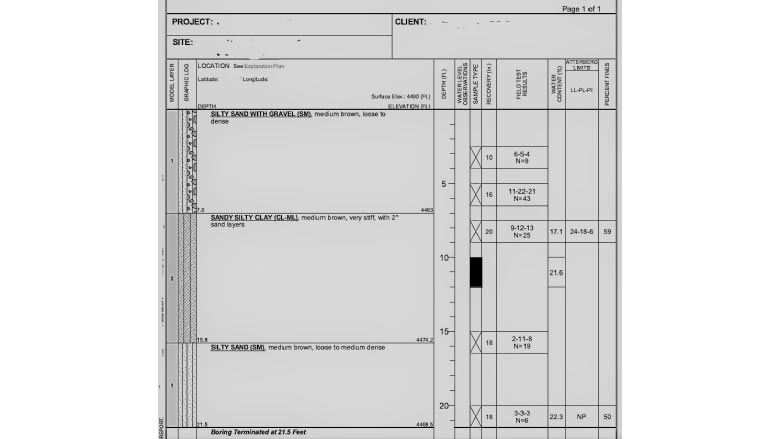Drilling for Soil Chemistry in Geotech Reports, Part 1
Geotechnical Reports for Drillers 101 plus Reading Bore Logs

A geotechnical report produced prior to a construction project can be of great use to a driller if it contains the right information. The details in these geotech reports can often give a drilling contractor all the information needed to determine the requirements to drill successfully — everything from fluid design to tooling selection. Of course, not every report has every necessary detail, but many offer as least some useful clues.
For example, few have information on soil chemistry regarding soluble salts, or chemicals that easily dissolve in water and can increase salt content. Typically, geotech reports offer only hints to this type of information — hints that we will have to pick through to find the information that we need. In this article and a follow-up one, I hope to show you what you can still glean from these more “minimalist” geology reports. Here, we help you get started with geotechnical reports, and then dive right into the bore logs.
Getting Started with Geotechnical Reports
We have really just two main classes of information to find. First, we need to know something about the soil porosity (i.e., cobbles vs. clays). We also need to know about the soil chemistry. This article and its follow-up focus mostly on the latter.
Salts and pH extremes have a strong impact on bentonite and polymers. Given that, the most useful data a geotech report provides for the driller concerns groundwater. Keep an eye out for any of this information.
- Soluble salts in groundwater
- pH of groundwater
- Total hardness of groundwater
Surprisingly, the historical section of the geotech report can give us clues as to what to expect onsite. These clues can help a driller target their drilling fluid formulation.
Most geotechnical reports begin with a table of contents, followed by a brief project overview and then an equally brief jobsite history, with any testing data generally at the end or in an appendix. Surprisingly, the historical section of the geotech report can give us clues as to what to expect onsite. These clues can help a driller target their drilling fluid formulation. Consider these examples:
- Site location: Is the site urban or rural? In the U.S. North or South? In rocky geology or a flat prairie? In an arid vadose zone or marsh? Each of these locations can tell you something.
- Previous use: Did the site have a previous industrial use? Industrial and urban areas almost always have more salts and hydrocarbons in the soil than rural areas.
- Proximity to the ocean: These areas are historically difficult to drill, as high-soil salt ruins most aqueous drilling fluids.
- Urban areas with long, cold winters: These more northern areas tend to use a lot of road salt and can have soil-salinity levels in line with what you might expect in, say, in Miami Beach.
Put the clues together in a way that makes sense for your fluids program. For example, are you drilling in an urban area in the North or near an ocean? Always assume you might have to add some type of salt-tolerant additive such as xanthan gum or PAC to prop up a flocculated slurry. Remember too that many areas have hard water that requires soda ash pre-treatment. Areas in northern Canada or bogs in northern Minnesota have peat. This is where experience and history can help tremendously — but sometimes a simple USGS geology map search can also save hours of frustration.

A generic borehole log showing geology at various levels below ground.
Source: Terracon Consultants Inc. Geotechnical Engineering Report, August 2022, via CETCO Drilling Products
Bore Logs
A geotech report often includes one or more bore logs (see picture). A bore log typically shows vertical bars arranged in rows under an overhead plot of the site showing the locations of drilled holes. Each bar splits into various colors or textures that denote types of geology. Notes next to each depth section explain a bit about the soil density and hardness found at that depth, as well as any gases present and the general appearance of the soil.
Primarily, you want to scan these logs for three types of information helpful when formulating a drilling mud.
- First, the geology at various depths can indicate whether you might use certain ingredients. For example, if the bore log indicates shows primarily gravels and small cobbles between 13 and 27 feet, you would make sure to have a loss circulation and filtration additives on hand. If the bore then changes into fine silts and clays, you will also want to have detergents and encapsulation polymers available.
- Second, potential warnings of adverse ground chemistry. Common indicators include notes about peat, coal, high organic content or even pyritic/acid-sulfate soils. You won’t often see warnings about low pH in a stratum but knowing that peat zones have low pH can save a lot of headaches. Avoiding such zones altogether might be a choice, but if not, have plenty of soda ash and even caustic soda on site.
- You also want to look for any suggestion of “back fill” or “waste fill.” This very coarse-grained material and can act as a sponge for drilling fluids. Getting through these zones often requires large-sized lost-circulation media (LCMs) of course. Many of these fill zones can also contain significant concrete waste. Concrete and cement tend to be slightly soluble for long periods. Soil zones with high concrete waste content will often have very high pH (12 and above) with high calcium hardness as a result. Despite having a high pH, cementitious zones can badly flocculate your mud. Drillers should consider having bicarbonate or an acid-phosphate like SAPP on hand when drilling through concrete fill. Try to maintain a fluid pH between 8 and 11 by dosing in these hardness-sequestering agents.
We’ve talked a lot about what you can glean about soil chemistry from geotechnical reports. However, this installment just covered the basics like getting started and reading bore logs. Next time, we get into more detail, starting with the potentially the most useful — yet frustrating — part of any geotechnical report: the data tables.
Looking for a reprint of this article?
From high-res PDFs to custom plaques, order your copy today!




